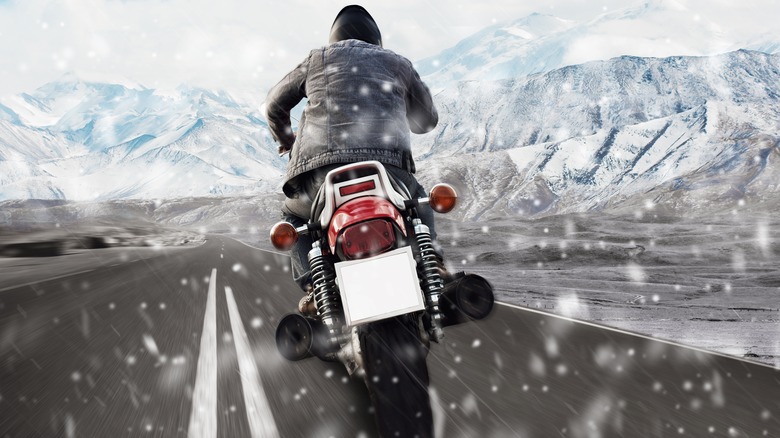A winter ride on a motorcycle can transform from a routine jaunt into a daring expedition when the weather turns cold and roads white up. Studded motorcycle tires are often discussed as a specialized solution for those harsh conditions, offering enhanced traction on icy and snow-covered surfaces. They are not a universal fix; their effectiveness depends on the riding surface, local regulations, and the rider’s skill and preparation. In this piece, we explore how studded tires work, where they shine, where they falter, and what alternatives exist for riders who need winter capability without compromising safety or budget. Drawing on real-world observations from cold-weather rides through the Rocky Mountains and beyond, we’ll provide a thorough, field-tested look at whether studded tires are worth considering for your winter riding needs.
Studded motorcycle tires 101
Studded motorcycle tires are built with embedded metal studs or spikes designed to bite into ice and compacted snow, creating improved traction where conventional tires struggle. The exact number, arrangement, and type of studs vary depending on the tire’s tread pattern and the specific stud used. The primary purpose of the studs is to provide increased grip during acceleration, braking, and cornering on icy or hard-packed surfaces. Think of the studs as miniature cleats that anchor the tire’s contact point with the slick surface, allowing for more reliable directional control and more predictable handling under winter conditions.
Several practical considerations shape the effectiveness and availability of studded tires. For one, major tire manufacturers typically do not sell studded motorcycle tires directly to consumers. Brands like Dunlop and Pirelli are notable for their reputation and performance in standard tire lines, but studded variants are a niche product and are usually not part of their consumer catalog. As a result, buyers who want studded tires often seek pre-studded sets through specialty motorcycle shops, independent tire distributors, or local service providers. In many cases, the wheels or tires you find with studs installed are sourced from lesser-known manufacturers such as Mitas, and the job is completed by a local technician or a professional shop.
The process of obtaining studded tires usually involves one of three paths. The first option is purchasing a tire that already comes with studs installed from a specialty shop. The second option is buying standard, studless tires and having studs installed by a professional mechanic or technician who specializes in winter tire modification. The third option is to undertake the studding yourself, which is generally not recommended for most riders due to safety, balancing, and ride quality concerns. In practice, most riders who need studded cameras or studs will rely on a professional installation to ensure the studs are properly spaced, oriented, and balanced so as not to compromise wheel performance or safety on the road.
The working principle behind studs is straightforward: they extend the tire’s contact interface with the surface, offering sharper initial bite on ice and enhanced edge stability on snow. When the surface is ice-bound, the studs dig in and resist sliding, providing a more predictable path for steering input and more robust braking response. On hard-packed snow, studs can help maintain traction where plain rubber would struggle. In off-road winter environments—such as snowy trails or frozen lakes—the benefits can be even more pronounced, with the studs contributing to improved confidence, control, and stability during aggressive maneuvers, climbs, or sudden shifts in direction.
A common misconception is that studded tires are universally beneficial regardless of road conditions. In reality, their advantages are highly surface-specific. When you encounter dry pavement, wet pavement, or bare roads, the metal studs can become a liability. On dry or merely wet surfaces, the studs act like tiny ball bearings under the tire, reducing traction rather than increasing it. This can lead to reduced grip, longer stopping distances, and a higher risk of losing control—especially with two-wheel dynamics, which lack the redundancy of four-wheel traction in a car. For this reason, many riders reserve studded tires for dedicated winter sessions on surfaces with ice and hard-packed snow and transition back to studless rubber when roads are clear of winter hazards.
The cost and maintenance implications are also important. Studded tires carry an upfront premium due to the added manufacturing complexity and the specialized installation work required. Over time, studs can wear down, become loose, or cause irregular tread wear if misaligned or improperly installed. Road damage is another factor often cited with studded tires; in some jurisdictions, studs can contribute to pavement wear, which may influence seasonal usage restrictions or maintenance requirements on certain roadways. These economic and regulatory considerations underscore the importance of careful planning: align your riding plans with local laws, weather forecasts, and the expected surface conditions for the ride.
In summary, studded motorcycle tires are a specialized winter equipment option designed to enhance traction on ice and hard snow. They require thoughtful procurement and professional installation in most cases, and their performance benefits are highest in environments with ice and deeply packed snow. They are not a universal fix for winter riding and must be paired with appropriate riding gear, cautious riding techniques, and an awareness of road and legal constraints. With that foundation in mind, it’s useful to consider when studded tires truly shine and when they may be better left in storage until conditions demand their presence.
How they work in practice
When the surface provides a solid icy surface or compacted snow, the studs provide a mechanical grip that standard tires cannot offer. In such cases, acceleration can be more measured and controlled; braking can be shorter and more predictable; and cornering can be more stable with a firmer sense of directional resistance to side-to-side slip. The studs effectively transform a portion of the tire’s contact into a traction-enhancing interface suitable for winter surfaces. The feel can be compared to adding traction anchors to your tire’s footprint, which helps you stay planted on the surface rather than slide uncontrollably.
However, on bare pavement or in wet conditions that do not feature ice, the studs can reduce grip. This is a key distinction that riders must internalize: studded tires are not a universal improvement for winter riding; they are a situational improvement that comes with tradeoffs in certain conditions. The decision to use studded tires should therefore consider the typical riding surface you encounter, not only the cold climate or the potential for winter weather.
The good and the bad
The decision to use studded tires hinges on balancing benefits and drawbacks across the different winter riding scenarios you may face. In off-road winter environments, such as snowy trails or frozen lake surfaces, studded tires can significantly enhance handling and safety. The enhanced traction makes it easier to control the motorcycle when traversing uneven surfaces or negotiating tight turns on compacted ice. Riders who regularly partake in off-road winter adventures may find that studded tires extend the seasonal window and improve ride enjoyment, enabling more consistent progress after the first snows fall. In these contexts, the studs help with acceleration, braking, and steering, reducing the risk of losing traction in conditions that are notoriously unpredictable.
On the road, studded tires present a more nuanced picture. On surfaces that are ice-covered or heavily packed with snow, they provide clear advantages and can improve rider confidence, particularly during braking and at lower speeds when traction is most critical. Braking in winter conditions is a complex mix of modulation and anticipatory control; in icy patches, studs can help you feel more secure and allow for more predictable deceleration. However, problems arise when you encounter dry, wet, or bare pavement. On such surfaces, the studs may perform as poorly as or worse than conventional tires, potentially increasing stopping distances and reducing cornering grip. The risk is particularly acute for riders with limited experience in winter riding or for those who push beyond conservative limits.
Cost is another factor to weigh. Studded tires require a higher upfront investment than standard winter tires due to the added labor and manufacturing steps involved in embedding the studs. In some cases, installation must be performed by a professional, adding to the overall expense. Additionally, there is ongoing maintenance to monitor stud integrity, ensure proper stud spacing, and check for wear that could affect performance or safety. The potential for road surface damage, while context-dependent, is a consideration some riders take seriously when deciding whether to operate studded tires in winter conditions or to switch to non-studded alternatives for city commutes.
Another dimension is regulatory compliance. In some regions and during certain windows of the year, laws and rules govern studded tires, limiting when and where they can be used. For riders who frequently travel between states or provinces with different rules, this is an essential aspect of planning. Before purchasing or installing studded tires, riders should verify local regulations to avoid penalties or unexpected road restrictions that could impact a winter itinerary or daily commuting.
In light of these factors, studded tires can be a valuable tool for riders who undertake winter riding in harsh climates and on surfaces that include significant ice and hard-packed snow. They can extend riding opportunities, promote confidence in challenging conditions, and improve control during critical driving tasks. For those who spend most winter days on pavement or who ride primarily in cities with frequent dry or wet patches, the drawbacks—reduced grip on non-ice surfaces, higher cost, potential road wear, and regulatory constraints—may outweigh the benefits. The careful rider will assess their typical winter routes, surface conditions, legal restrictions, and personal comfort on ice to determine whether studded tires belong in their toolkit.
Real-world considerations from a winter ride
A rider who has logged multiple winters in high-altitude environments can attest to the value of appropriate tires and gear when temperatures plummet and surfaces degrade rapidly. Being in an environment where ice and snow are the default, the right combination of tires and protective gear makes a meaningful difference in staying warm and maintaining control. Even if studded tires were not an option, selecting the best possible tires remains crucial, as some brands deliver consistently better performance in cold conditions. Equally important is staying warm through heated riding gear, which can significantly reduce fatigue and improve reaction times during extended winter sessions. Some riders opt to winterize their bikes, acknowledging that winter riding demands a different approach than fair-weather months.
For those who embrace winter riding as a year-round sport, studded tires can be a valuable tool in the toolkit. The decision to use them should be anchored in practical riding conditions, local laws, and a willingness to adapt riding style to the surface. If you lean toward off-road winter adventures, there is a strong case for considering studded tires as a primary option. If your winter riding is predominantly road-based, it is wise to weigh the tradeoffs carefully and consider alternatives that can offer consistent performance across a wider range of winter surfaces.
Alternatives to studded tires
If the goal is to maintain winter capability without relying on metal studs, several high-quality, non-studded winter tire options are designed to deliver solid performance on wet, snowy, and slushy surfaces. These tires use advanced tread patterns, sipes, and specialized rubber compounds to maximize grip in challenging cold conditions. European manufacturers have developed winter-specific lines that emphasize predictable handling and traction in winter weather, even without studs.
One notable example is the MC-32 winter tire from Mitas, designed to tackle wet roads, snow, and slush. These non-studded tires incorporate tread patterns and material technology intended to provide reliable grip in winter conditions. They can be a viable alternative for riders who want winter performance without the added complexity of studs. Heidenau, a German manufacturer, offers three non-studded snow tire models: the K 37S, K 58S, and K 62S. The K 58S and K 62S incorporate a proprietary rubber mix known as Snowtex to improve traction in sub-zero temperatures. These tires aim to deliver solid winter performance while preserving a smoother ride and reduced road wear compared to studded designs.
Turkish manufacturer Anlas also has three winter models designed to address cold, wet, and snowy road surfaces: the Winter Grip Plus, the Winter Grip 2 (SC-500), and the NR-50 WinterGrip. These models rely on winter tread patterns, advanced polymers, and silica technology to maximize traction in challenging winter conditions. The emphasis with these non-studded options is to optimize grip and stability across a broad range of winter surfaces, including wet and cold roads, without introducing the potential downsides associated with studs.
Beyond these branded lines, there are practical rider strategies that can compensate for not using studs. Reducing speed, increasing braking distances, and riding with heightened awareness of changing surface conditions become critical. Additionally, you can pair non-studded winter tires with appropriate riding techniques—such as smooth throttle control, gradual braking, and deliberate cornering—to maximize traction and stability on ice, slush, and snow. In regions with intermittent winter weather, riders may opt for a mixed approach, using winter-rated, non-studded tires for most commuting and switching to studded variants when the forecast strongly predicts a sustained period of ice or hard-packed snow.
For riders who must balance on-road and off-road winter use, the non-studded options, with the right compound and tread design, can provide a broader range of performance across surfaces. If you cannot locate specific non-studded winter tires or if you regularly ride on ice and snow on off-road paths, you may still consider studded tires as a specialized tool for those particular scenarios. The decision will depend on your typical winter routes, your tolerance for risk on icy patches, and your willingness to manage the additional maintenance and cost associated with studs.
In short, there are credible, high-quality non-studded winter tire options from notable manufacturers that address the same challenges studded tires tackle. These options often provide more consistent on-road behavior across varying winter surfaces, albeit with potentially less bite on very icy patches. For riders who spend a significant portion of winter on paved surfaces with intermittent ice, non-studded winter tires may strike a favorable balance between safety, performance, and comfort. For those who frequently investigate icy off-road environments, studded tires remain a specialized and valuable tool within a broader winter-riding strategy.
Acquiring, installing, and maintaining studded tires
If you decide that studded tires align with your winter riding goals, the acquisition and installation process requires deliberate planning. Because studded tires are a niche product and not widely distributed through primary manufacturers, you will typically look to specialty shops or independent tire vendors that offer pre-studded tires or studded-up services. When you locate a reputable source, you should inquire about the studs’ type, the spacing, and the overall balance and alignment of the tires after installation. Proper installation by a qualified professional is strongly recommended to ensure that the studs are correctly seated, evenly spaced, and balanced to minimize vibration and uneven wear.
Pricing for studded tires will vary based on the tire model, stud configuration, and installation charges. Expect a premium over standard winter tires due to the additional labor required to install and verify stud integrity. It is also prudent to budget for ongoing maintenance checks during the winter season to monitor stud wear and ensure continued performance. If you opt to install studs yourself, take into account the importance of precise spacing and depth to avoid unbalanced wear and potential safety hazards. The safest approach remains professional installation, especially for riders who rely on winter performance to navigate extreme weather or challenging terrain.
Before making a purchase, we recommend evaluating your typical winter routes and climates. If you expect long drives on icy highways, you should consider whether studs will provide a meaningful safety benefit on those specific surfaces. If your winter riding consists mostly of off-road trails or frozen lakes where ice is a frequent feature, studs may offer clear advantages in control, acceleration, and braking. If your winter riding is mostly urban or suburban, with frequent dry or wet pavement alongside occasional ice, you may need to balance your use of studs with the potential hazards of on-road studded performance and the possibility of increased wear or road impact.
When choosing a model, pay attention to the tire’s construction, the tread pattern suited for cold climates, and whether the tire allows for optional stud installation in a controlled manner. Some models provide predefined spaces to mount studs, enabling you to customize your grip for higher-intensity winter conditions. For certain riders, the ability to install or remove studs depending on weather forecasts offers a flexible approach to winter riding. If you are in a region where winter conditions are variable, dismountable or semi-studded configurations may be appealing because they provide a balanced compromise between studded traction and street-surface safety.
Finally, it is essential to integrate studded tires into your broader winter riding plan. Stock up on protective riding gear and maintain a steady maintenance routine for your bike. The focus should be on staying warm, being visible, and adjusting riding style to the ice, snow, and weather forecast. With the right preparation and a sound understanding of when studded tires deliver real benefits, you can maximize winter riding safety and enjoyment, while minimizing the downsides and potential hazards associated with this specialized equipment.
Safety, riding strategies, and winter considerations
Winter riding demands a heightened emphasis on safety. Even with studded tires, you must adopt a disciplined riding approach that accounts for reduced traction, changing weather conditions, and longer stopping distances. A few key strategies can help you stay safer on the road, whether you are using studs or not.
- Speed management: Reduce speed to accommodate limited traction on ice and snow, and allow extra time for braking and acceleration. The faster you ride on icy surfaces, the higher the risk of a loss of control, particularly during unexpected shifts in surface conditions or when encountering patches of bare pavement.
- Distance planning: Increase following distances to account for the longer stopping distances that winter surfaces impose. Understand the limitations of your tire setup and ride with the awareness that a sudden action—such as an emergency brake or an abrupt lane change—could have severe consequences on ice.
- Traction-aware braking: Practice progressive braking early in each ride to calibrate how your tires respond to different levels of grip. With studded tires, you may notice a stronger bite on ice but a delayed or less predictable response on bare patches. Learn how much pressure you can apply before the tires start to slip, and adjust your braking style accordingly.
- Cornering discipline: On ice and hard-packed snow, maintain smooth steering inputs and avoid abrupt throttle changes that can unsettle traction. When turning, avoid late or aggressive corner entries that could push you toward a loss of control. With studs, you’ll experience improved edge grip, but you still need careful body positioning and deliberate hand-lever actions to maintain control through corners.
- Gear and clothing: Heated riding gear, proper gloves, and breathable layers can significantly impact your comfort and concentration, particularly during long winter rides. Being warm reduces fatigue and enhances your ability to respond quickly to changing road conditions.
- Route planning: Study weather and road conditions before departure. If forecasts indicate significant ice accumulation or rapid snow changes, consider altering your route or postponing the ride. In some cases, it may be prudent to switch to non-studded tires if the forecast predicts persistent road conditions that would benefit from broad grip across mixed surfaces.
- Legal awareness: Check local regulations regarding studded tires, seasonal restrictions, and permitted usage windows. Regulations can vary by jurisdiction, and ignorance can lead to penalties or unsafe ride planning. Ensure you comply with all local laws and adjust your equipment choices per the regulatory context.
- Maintenance focus: Regular inspection of studs, tread, and tire balance is essential. Misaligned or worn studs can reduce traction and accelerate tire wear. If you notice any irregularities, seek professional service to adjust, replace, or rebalance the tires to maintain reliable winter performance.
In addition to these operational considerations, riders should adopt a mindset that prioritizes safety, patience, and adaptability. Winter riding involves unpredictability: a patch of black ice, a sudden freeze-thaw cycle, or a snow-covered curb can all alter surface grip dramatically. Studded tires are a powerful tool, but they do not eliminate the need for prudent judgment, continuous learning, and careful route selection. Pairing studded tires with robust winter gear, deliberate riding technique, and an informed understanding of local conditions will maximize your chances of staying safe and comfortable on cold-weather rides.
Conclusion
Winter motorcycle riding demands a careful balance between traction, control, and risk management. Studded motorcycle tires provide a targeted solution for icy and hard-packed snow surfaces, offering improved grip during acceleration, braking, and turning in those conditions. They are best suited for riders who regularly encounter off-road winter terrain or long stretches of ice-lrozen surfaces where conventional tires struggle to hold traction. The decision to use studs hinges on your typical riding surfaces, local laws, and your willingness to manage the additional cost and maintenance involved. For riders who spend most winter days on paved roads or in regions with frequent dry or wet patches, non-studded winter tires may deliver more consistent performance across a broader range of surfaces, reducing the likelihood of reduced grip on bare pavement.
In practice, a hybrid approach often works best: equip studded tires for truly icy, off-road, or hard-packed winter scenarios; switch to non-studded winter tires for regular road commuting when surfaces are mostly dry, wet, or lightly snow-covered. Regardless of the choice, prioritize safe riding practices: reduce speed, allow extra braking distance, and ride with deliberate, anticipatory actions. The right tire setup, combined with appropriate gear, careful route planning, and adherence to safety and legal guidelines, can turn winter riding from a hazardous challenge into a manageable, even enjoyable, extension of the riding season. With thoughtful preparation and a clear understanding of where studs shine—and where they don’t—you can tailor your winter tire strategy to your riding style, climate, and everyday needs, unlocking safer, more confident winter adventures on two wheels.



